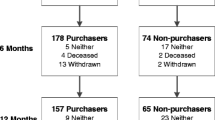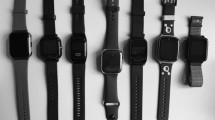Abstract
Background
Despite a wide distribution, little is known about the relationship between subscriber satisfaction and the extent of use or non-use of personal emergency response systems (PERS).
Objectives
To examine the degree of satisfaction with PERS, the wearing time and its use in case of a fall.
Study design and setting
Telephone and face-to-face interviews were conducted with 52 elderly community-dwelling PERS users.
Results
PERS subscribers were very satisfied with their device; however, 24% of the participants reported that they never wear the alarm button, and only 14% wear it 24 hours each day. After falls PERS was not activated by 83% (n=11) of the subscribers who fell alone and lay on the floor longer than 5 minutes. None of the five different satisfaction measures and only the subscriber’s estimation of relevance of the PERS showed to be a significant predictor of PERS use in daily life.
Conclusions
High rates of non-use of PERS in everyday life and after falls can be found. Subscribers’ estimation of relevance but not satisfaction predicts the usage of PERS in everyday life. Further research is needed to better understand the reasons not using a PERS.
Zusammenfassung
Hintergrund
Trotz einer hohen Verbreitung der Hausnotrufsysteme ist der Zusammenhang zwischen der Zufriedenheit von Hausnotrufkunden und der Nutzung bzw. Nichtnutzung des Systems weitgehend unerforscht.
Ziel
Evaluation der Zufriedenheit von Hausnotrufkunden und der Nutzung des Hausnotrufsystems im Alltag sowie nach einem Sturz.
Studiendesign und Setting
Mit 52 Hausnotrufkunden wurde ein telefonisches oder persönliches Interview geführt.
Ergebnisse
Hausnotrufkunden waren mit ihrem System sehr zufrieden. Allerdings berichteten 24% der Studienteilnehmer, den Notrufsender nie zu nutzen, und nur 14% trugen ihn immer bei sich. Von den Hausnotrufnutzern, die allein gestürzt waren und länger als 5 Minuten am Boden lagen, aktivierten 83% (n=11) ihren Hausnotruf nicht. Nur die Einschätzung der Wichtigkeit, aber keines der fünf verschiedenen Zufriedenheitsmaße erwies sich als signifikanter Prädiktor für die Nutzung des Hausnotrufs im Alltag.
Schlussfolgerungen
Es zeigte sich, dass das Hausnotrufgerät im Alltag und nach einem Sturz häufig nicht genutzt wird. Nur die Einschätzung der Bedeutsamkeit des Hausnotrufs und nicht die Zufriedenheit mit dem Gerät sagt dessen Nutzung im Alltag voraus. Weitere Untersuchungen sind nötig, um die Gründe der Nichtnutzung besser zu verstehen.
Similar content being viewed by others
References
Avlund K, Kreiner S, Schulz-Larsen K (1996) Functional ability scales for the elderly. A validation study. Eur J Public Health 6:35–42
Bernstein M (2000) Low-tech personal emergency response systems reduce costs and improve outcomes. Manag Care Q 8:38–43
Bundesverband Hausnotruf (2010) http\\:www.bv-hausnotruf.de, cited April 29, 2010
Callahan CM, Unverzagt FW, Hui SL et al (2002) Six-item screener to identify cognitive impairment among potential subject for clinical research. Med Care 40:771–781
Celler B, Lovell NH, Chan DK (1999) The potential impact of home telecare on clinical practice. Med J Aust 171:518–521
Constien J, Wetzel E (2002) Hausnotruf ermöglicht mehr Sicherheit zu Hause. Pro Alter 1:60–65
CrockerL, Algina J (1986) Introduction to classical and modern test theory. Holt, Rhinehart, Winston, New York
Davis F (1989) Perceived usefulness, perceived ease of use, and user acceptance of information technology. MIS Quart 13:319–339
Demers L, Weiss-Lambrou R, Ska B (1996) Development of the Quebec user evaluation of satisfaction with assistive technology (QUEST). Assist Technol 8:3–13
Demers L, Weiss-Lambrou R, Ska B (2000) Item analysis of the Quebec user evaluation of satisfaction with assistive technology (QUEST). Assist Technol 12:96–105
Demers L, Weiss-Lambrou R, Ska B (2000) Quebec user evaluation of satisfaction with assistive technology: QUEST version 2.0. The Institute for Matching Person & Technoloy, Inc., Webster, USA
Dibner AS (1990) Personal emergency response systems: communication technology aids elderly and their families. J Appl Genet 9:504–510
Doughty K, Cameron K, Garner P (1996) Three generations of telecare of the elderly. J Telemed Telecare 2:71–80
Fallis WM, Silverthorne D, FranklinJ et al (2007) Client and responder perceptions of a personal emergency response system: Lifeline. Home Health Care Serv Q. 26:1–21
Fleming J, Brayne C (2008) Inability to get up after falling, subsequent time on floor and summoning help: prospective cohort study in people over 90. BMJ 337:a2227
Gitlin L, Schemm R, Landsberg L et al (1996) Factors predicting assistive device use in the home by older people following rehabilitation. J aging health 8:554–575
Hoyl MT, Alessi CA, Harker JO et al (1999) Development and testing of a five items version of the Geriatric Depression Scale. J Am Geriatr Soc 47:873–878
Levine DA, Tideiksaar R (1995) Personal emergency response systems: factors associated with use among older persons. Mt Sinai J Med 62:293–297
Mann W, Goodall S, Justiss MD et al (2002) Dissatisfaction and Non-use of Assistive Devices among frail elders. Assist Technol 14:130–139
Mann WC, Belchior P, Tomita MR et al (2005) Use of personal emergency response systems by older individuals with disabilities. Assist Technol 17:82–88
Marx J (2006) Fünfundzwanzig Jahre DRK-Hausnotruf. Eine Dokumentation. Deutsches Rotes Kreuz Generalsekretariat
Oliver R (1980) A cognitive model of the antecedents and consequences of satisfaction decisions. J Mol Recognit 17:460–469
Roman K (2002) Technik im Alltag von Senioren. Arbeitsbericht zu vertiefenden Auswertungen der sentha – Repräsentativerhebung. Teilprojekt Sozialwissenschaften (DZFA, BIS) der interdisziplinären Forschergruppe sentha, Heidelberg
Roush RE, Teasdale TA (1995) Impact of a personal emergency response system on hospital utilization by community-residing elders. South Med J 88:917–922
Ruchlin HS, Morris JN (1981) Cost-benefit analysis of an emergency alarm and response system: a case study of a long-term care program. Health Serv Res 16:65–80
Sherwood S, Morris JN (1980) A study of the effects of an emergency alarm and response system for the aged: a final report. Grant No. HS01788, National Center for Health Services Research
Spreng RA, MacKenzie SB, Olshavsky RW (1996) A reexamination of the determinants of consumer satisfaction. JM 60:15–32
Szajna B (1996) Empirical evaluation of the revised technology acceptance model. Manage Sci 42:85–92
Vincent C, Reinharz D, Deaudelin I et al (2006) Public telesurveillance service for frail elderly living at home, outcomes and cost evolution: a quasi experimental design with two follow-ups. Health Qual Life Outcomes 1:4–41
Wixom BH, Todd PA (2005) A Theoretical integration of user satisfaction and technology acceptance. ISR 16:85–102
Conflict of interest
The corresponding author states that there are no conflicts of interest.
Author information
Authors and Affiliations
Corresponding author
Rights and permissions
About this article
Cite this article
Heinbüchner, B., Hautzinger, M., Becker, C. et al. Satisfaction and use of personal emergency response systems. Z Gerontol Geriat 43, 219–223 (2010). https://doi.org/10.1007/s00391-010-0127-4
Published:
Issue Date:
DOI: https://doi.org/10.1007/s00391-010-0127-4




